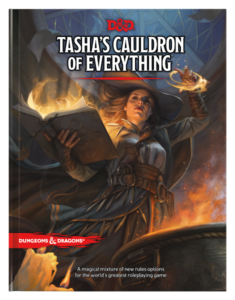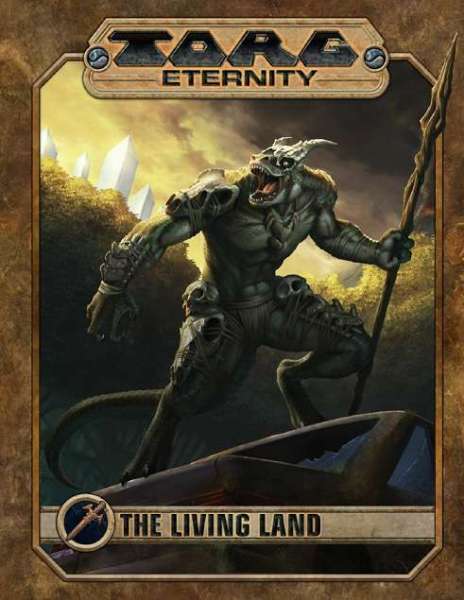
Tasha’s Cauldron of Everything
Tasha’s Cauldron of Everything is a supplement for Dungeons & Dragons, written by Jeremy Crawford, Dan Dillon, Ben Petrisor, F. Wesley Schneider, and Elisa Teague and published by Wizards of the Coast.
By Dave Pierson

Learn more about Tasha’s Cauldron of Everything here
Purchase Tasha’s Cauldron of Everything here (paid link)
Find other Dungeons & Dragons posts here
The Homebrew DM’s Perception
Disclaimer: Contained herein are the observations of the archmage Tasha. Later known as the Witch Queen and then Iggwilv, she is one of the greatest wizards in the history of the multiverse. We fear there is an incantation hidden within these notes and have therefore bound this tome with powerful wards. If you are reading this, the first ward has already been broken! If you dare read any further, we cannot guarantee the safety of your soul or that you won’t open a portal to another plane of existence. If a portal does appear, pray that nothing worse than Tasha’s mother Bab Yaga appears. And if the mother of hags arrives, be sure to offer only praises of her daughter. Or offer muffins. She loves muffins.
– Wizards of the Coast, Tasha’s Cauldron of Everything, 2020
Happy New Year! Out with the old; in with the new. It’s been a couple months since Tasha’s Cauldron of Everything was released, but a couple months were needed to really dive into this release. 2020 found many of us having to adjust our gatherings and playstyles, and my group was no exception. I mention this as at the time of Tasha’s release, our little group decided to give virtual play another try so we could continue to play our favorite game safely. What a perfect way then to try some new ideas out!
Tasha’s Cauldron of Everything was being touted as the next big sourcebook to be released with the promise of new subclasses, new spells, and new mechanics. I mean they needed to do something with all the playtest material they had going, right? Overall, the book does provide some good material for both your PCs and you as a DM, but there was one major part I felt was lacking. So let’s dive in and take a look.
For your players, the best section is chapter one, as it introduces new subclasses for pretty much every class, some with multiple options. If your players have been following along with Wizard’s Unearthed Arcana playtest material, they are going to notice many of the subclasses first introduced being reprinted for official use, including Psionics. They also reprinted the Artificer class from 2019’s Eberron: Rising and added a new subclass, the armorer. You pretty much get to play Iron Man, shooting lightening our of your chest or going full tank and punching with gauntlets. In my opinion, if you’ve got a player looking for something newer than the standard options, chapter one would be a great starting point for them. Hint – A Genie Warlock is pretty cool to play.
Chapter two introduces Group Patrons, a handy little mechanic to really build a campaign around that can transverse multiple settings. Patrons give your adventuring party a reason to adventure with opportunities abound for everyone. Really, it’s taking a mechanic from their setting books, like working for a faction within Waterdeep, and expanding it to be more “global.” And honestly, I’m thinking many of us homebrew DM’s may already incorporate something very similar to this concept already. Either way, a great tool for DM’s when setting out the story in front of our players.
Chapter three is your standard “here are some new spells and magic items for your players,” with most of the focus on enhancing the new subclasses presented in Tasha’s. A bunch of new types of summoning. There’s also a little talk on how to make the spells your own, changing a word here or there to fit your personality.
The book finishes up with a dump of information under the guise of Dungeon Master’s tools. The information provided on how to hold a session zero is informative for kicking off a new campaign, with new players that may not have played with you before. Now, we’ve been playing with the same group for quite a long time, but there have been times when someone new joins us. A sessions zero is important to lay out the expectations for both existing and new players to build a comfortability with each other. It may only be a few pages long, but it’s an important topic to be covered for sure.
Another great topic introduced in this chapter is sidekicks. Previously introduced in playtesting, sidekicks can really help round out your party when missing a player or even introducing someone new to the game. And honestly, as the DM, having a few of them handy to throw in when your resident healer can’t make a session is a good way to keep the story moving while the cleric is dealing with a pandemic in the nearby town.
Earlier I mentioned there was one major part I felt was lacking. When Paizo announced they were launching Pathfinder 2.0, one of the many updates they were looking to instill was dropping the term race and moving towards using Ancestries to describe the culture in which your character hails from. This was a big change in my mind to fundamental thinking of how we describe our characters to others and honestly felt it was a move in the right direction. Then, in June 2020, Wizard’s formally acknowledged the existence of racist stereotypes in it’s sourcebooks and that Wizard’s was going to begin to adjust and be more conscious of how fantasy races were being characterized in their future productions. They even noted that in an upcoming release [Tasha’s] they would offer ways for a player to customize their character’s origin, including ability scores, to “emphasize that each person in the game is an individual with capabilities of their own.”
Now, I wasn’t expecting Wizard’s to go out and start throwing out new terminology like Ancestry, but I was expecting a bit more than what they presented in Tasha’s – a half page at most advising that if you don’t like the options presented, ignore the rules for character creation and do what you want. For example, if the ability score increase for your race/subrace increases your Constitution by 2 and Wisdom by 1, feel free to increase your intelligence by 2 and your Charisma by 1, as long as you remain with the same guidelines of the 2/1 increase. And really this advice, to me, is buried and easy to overlook unless you are really diving in. Don’t get me wrong, I like the freedom this presents and the removal of a guiderail that is not game breaking. However, Wizard’s had an opportunity here to really push Dungeons and Dragons forward into new a progressive territory. That’s not to say they won’t, and Tasha’s could have been too close to print to make a more sweeping change. I just hope that my favorite game to play continues to do better.
Overall, Tasha’s Cauldron of Everything is a really good sourcebook for players and DM’s. There is a multitude of information that us Homebrew DM’s can use to grow our own settings, present our player’s more options, and really look to carry on legacy campaigns that evolve over time.


